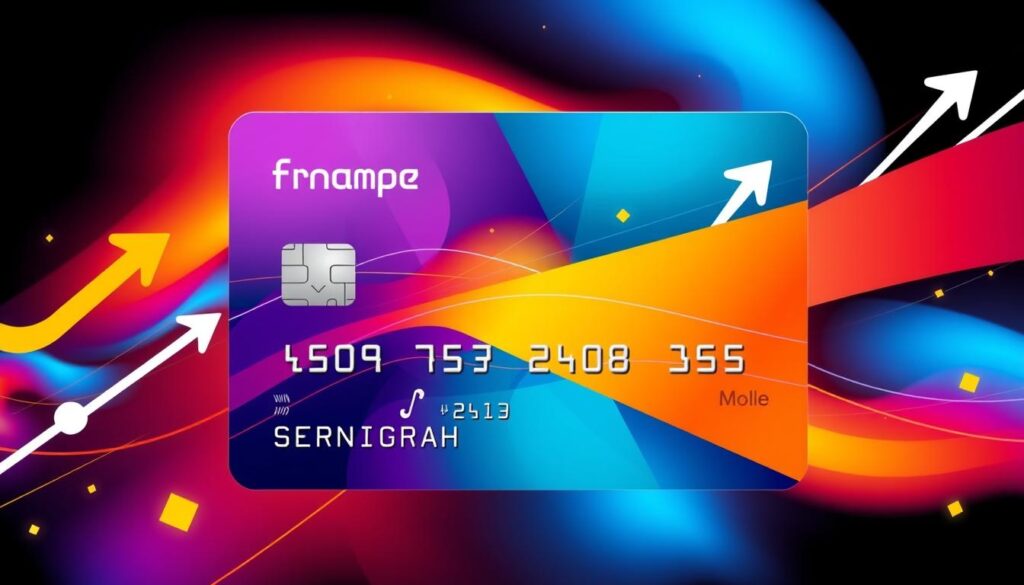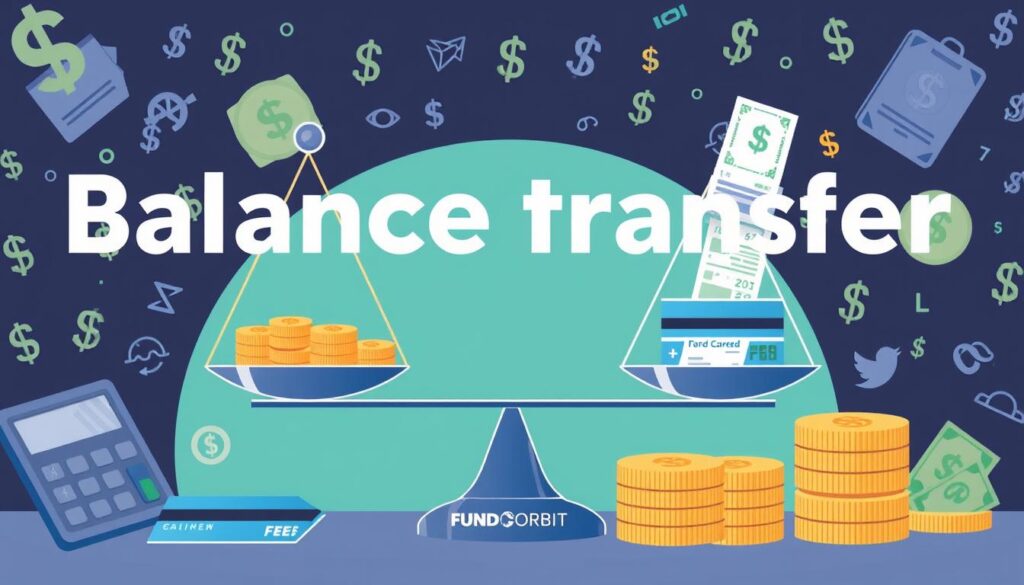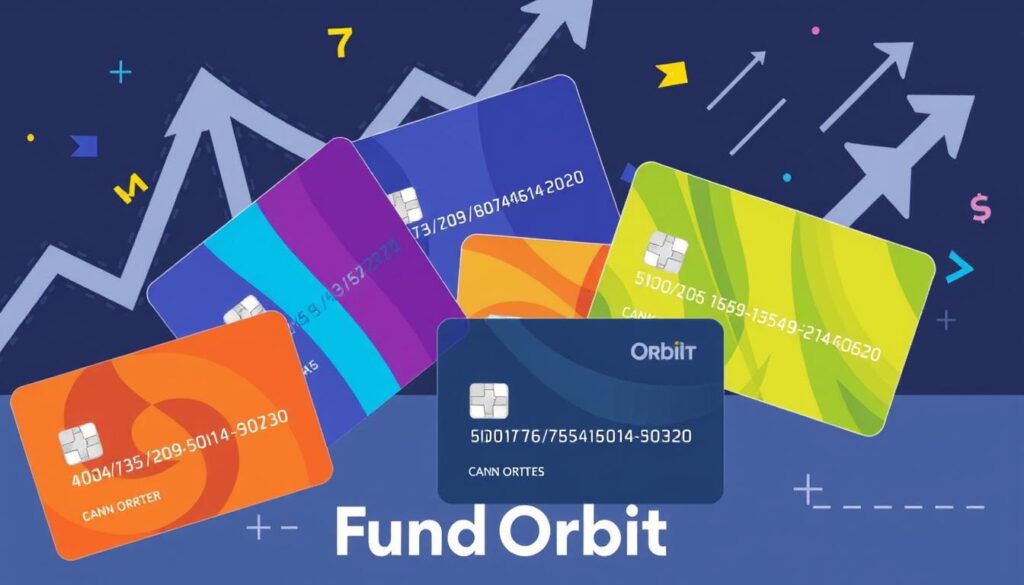High-interest credit card debt can be tough to handle. But, there are ways to save money and pay off debt quicker. Balance transfer credit cards offer lower interest rates and help you manage your debt better. By moving your balance to a new card with a lower rate, you can save a lot on interest.
These cards are great for managing debt. With average American credit card debt around $5,315, many can benefit from a balance transfer. This can reduce interest payments and help you pay off debt faster.
Balance transfer credit cards have many benefits. They help you consolidate debt and save on interest. With 0% intro APR offers, you can pay off your debt quicker and avoid more interest. We’ll look into how to pick the right card and use these advantages to your advantage.
Key Takeaways
- Balance transfer credit cards can help us save money on interest and pay off debt faster.
- The benefits of balance transfer credit cards include lower interest rates and balance transfer advantages.
- Transferring our existing credit card balance to a new card with a lower introductory APR can potentially save hundreds of dollars in interest charges.
- It’s essential to consider the benefits of balance transfer credit cards when evaluating our credit card options.
- Balance transfer credit cards can be a valuable tool for managing debt and consolidating credit card debt.
- By taking advantage of balance transfer advantages, such as 0% intro APR offers, we can pay off our debt faster and avoid accruing more interest.
What is a Balance Transfer Credit Card?
A balance transfer credit card lets you move your debt to a new card with a lower interest rate. This can save you money and help you pay off debt faster. These cards often have 0% introductory APRs, which can save you hundreds or thousands of dollars in interest.
Understanding how balance transfers work is key. Balance transfer fees are usually 3% to 5% of the amount you transfer. For instance, moving a $1,000 balance with a 5% fee costs $1,050 in total.
To get the best balance transfer deals, you need good or excellent credit, above 700. Also, you might only be allowed to transfer a part of your debt. Always check the card’s terms and conditions to make sure it fits your financial situation.
| Balance Transfer Fee | Total Transfer Amount | Total Payment |
|---|---|---|
| 3% | $1,000 | $1,030 |
| 5% | $1,000 | $1,050 |
Key Benefits of Balance Transfer Credit Cards
Understanding the benefits of balance transfer credit cards is key. They help save money and pay off debt faster. One big plus is the chance to reduce interest rates on existing debt. This can save thousands of dollars in interest over time.
Another great benefit is the chance to consolidate debt into one payment. This is super helpful for those with many credit cards and high balances. It makes paying off debt easier and simpler.

The transfer credit card benefits and balance transfer benefits explained are quite good. Some cards offer interest-free periods from 6 to 18 months. This gives cardholders time to pay off debt without extra interest. Some cards also offer rewards for balance transfers.
When looking at balance transfer credit cards, consider a few things:
- Introductory interest-free period
- Balance transfer fee
- Regular interest rate
- Rewards or other incentives
By looking at these factors and choosing wisely, you can get the most out of your credit card. This helps you reach your financial goals.
Understanding Introductory Offers
When looking at balance transfer credit cards, it’s key to grasp the introductory offers. These deals can cut down on interest and speed up debt repayment. A big plus of balance transfers is the chance to lower your interest rates.
The main reason why use balance transfer credit cards is the 0% APR for a set time, usually 6 to 18 months. This can save you a lot on interest. For instance, moving a $3,000 balance from an 18% APR card to a 0% intro APR card for 12 months can save $540 in interest.
Types of Introductory APR Offers
There are different kinds of introductory APR offers, like 0% APR for a short time and balance transfer fees. It’s important to know the terms and conditions of these offers. The advantages of transferring credit card balances include combining debt, lowering interest rates, and saving on interest payments.

Timeframes of Introductory Periods
The length of introductory periods varies, but they usually last from 6 to 21 months. It’s vital to pick a card with a period that fits your financial goals and debt plan. By understanding these offers and choosing wisely, you can benefit from the advantages of transferring credit card balances and reach your financial targets.
Fees to Consider with Balance Transfers
When looking at balance transfer credit cards, knowing the fees is key. These fees usually range from 3% to 5% of the balance moved. For instance, moving a $10,000 balance could cost $300 to $500 in fees.
Balance transfer cards can save you a lot, over $1,300 in interest and fees. But, remember to include the fees in your total cost. You can check out financial websites for more on balance transfer benefits.
Here is a table summarizing the typical balance transfer fees:
| Balance Transfer Amount | Balance Transfer Fee (3%) | Balance Transfer Fee (5%) |
|---|---|---|
| $5,000 | $150 | $250 |
| $10,000 | $300 | $500 |

In conclusion, knowing the fees for balance transfers is vital. By understanding these costs and picking the right card, we can fully enjoy the benefits. This helps us reach our financial goals.
How to Choose the Right Card
When picking a balance transfer credit card, it’s key to think about a few things. We look for perks that match our financial goals. The interest rate and terms are very important because they affect how fast we can pay off debt.
A lower interest rate means big savings. This makes it easier to get out of debt.
Another important thing is how long the 0% interest rate lasts. Some cards offer this for over a year. This gives us plenty of time to pay off our debt without extra interest.
But, we should also know about the balance transfer fee. It’s usually between 3% to 5% of the amount we transfer. This fee can add up fast, so we need to consider it when making our choice.

- Interest rates and terms
- Rewards and benefits associated with the card
- Balance transfer fees and any other associated costs
- Duration of the 0% interest rate promotional period
By looking at these factors, we can pick a card that offers great perks. This helps us pay off debt and enjoy savings with balance transfers.
Strategies for Maximizing Your Balance Transfer
To get the most out of a balance transfer, knowing how to use it is key. We can save money and pay off debt quicker by using transfer credit card benefits wisely. One important strategy is to pay off debt fast by making more than the minimum payment each month.
This method helps lower the principal amount and cuts down on interest charges. Another essential step is setting up automatic payments to ensure we pay on time and avoid late fees. This keeps our credit score high and lets us fully benefit from balance transfer perks.
Some balance transfer cards offer 0% APR for 6 to 18 months. To maximize this, we should first transfer debt with the highest APR. Making timely payments is also critical to keep the introductory rate. By following these steps, we can effectively use transfer credit card benefits and reach our financial goals.
It’s also important to keep an eye on the average credit card interest rate. Knowing how it impacts our debt management is vital. With the right strategy, we can cut down on debt costs and make the most of balance transfer benefits in our credit card terms.
Common Myths About Balance Transfer Cards
When thinking about balance transfer credit cards, it’s key to know what’s real and what’s not. Many believe that balance transfers hurt your credit score. But, this isn’t always true. Applying for a new card might lower your score a bit due to a hard inquiry. Yet, actually moving your balance doesn’t directly hurt your credit.
Another myth is that all balance transfer deals are the same. But, this is far from true. Different lenders offer different terms, like interest rates, fees, and introductory periods. For example, some, like Navy Federal Credit Union, don’t charge balance transfer fees. Others do. Knowing the benefits of balance transfers can help you choose wisely.
It’s also important to remember that opening many new accounts can hurt your credit. But, moving your balance to a lower interest card can help in the long run. To get the most out of it, consider these tips:
- Check your credit report and score before applying for a balance transfer credit card.
- Compare offers from different lenders to find the best terms.
- Make timely payments to avoid late fees and negative credit reporting.

By knowing the truth and debunking myths, you can use balance transfer credit cards to your advantage. Always read the fine print before applying for a new card. And, if you’re unsure, talking to a financial advisor can be a good idea.
| Balance Transfer Fees | Interest Rates | Introductory Periods |
|---|---|---|
| 0% – 5% | 0% – 20% | 6 – 18 months |
The Impact on Your Credit Score
Understanding the impact of balance transfer credit cards on your credit score is key. Balance transfers can affect your score in both the short and long term. In the short term, they can lower your credit utilization rate, which can help your score.
For example, moving a balance to a card with a $5,000 limit can drop your utilization ratio from 63% to 28%. This is a big positive for your score.
But, applying for a new card for a balance transfer can lead to a temporary score drop. This is because of the hard inquiry into your credit history. Yet, paying off debts quickly can improve your score over time. This shows why it’s important to manage your finances well.
To keep your score stable during a balance transfer, avoid closing old accounts. Lenders like to see longer credit histories.
Short-Term vs. Long-Term Effects
The immediate effects of a balance transfer on your score might seem small. But, opening many new cards for transfers can hurt your score. On the other hand, managing your credit well over time can lead to a higher score.
The benefits of balance transfer cards, like lower interest rates, can save you money. They can also help improve your credit score in the long run.
Tips for Maintaining a Healthy Score
To keep your credit score healthy during a balance transfer, follow these tips:
- Keep existing credit lines open to maintain credit mix and average account age.
- Avoid closing older accounts, as longer histories are viewed positively by lenders.
- Make timely payments to demonstrate responsible financial behavior.
- Monitor your credit utilization ratio and keep it low to positively impact your credit score.
By understanding how balance transfers affect your score and following these tips, you can enjoy the benefits of these cards. The advantages, such as 0% interest rates, can save you money and improve your financial health.
| Credit Score Factor | Percentage |
|---|---|
| Payment History | 35% |
| Credit Utilization | 30% |
| Length of Credit History | 15% |
| Credit Mix | 10% |
| New Credit | 10% |
When a Balance Transfer May Not Be Ideal
Balance transfers can be very helpful, but they’re not always the best choice. If you have a lot of debt, even with credit card balance transfer perks like 0% introductory APRs, it might be tough to pay it off.
When you have a lot of debt, the savings from balance transfers might not be enough. It’s important to think about other ways to pay off your debt. Also, if you’re not good at managing money, balance transfers might not work well for you. This is because you could end up spending more and getting into more debt.
Here are some things to think about before deciding on a balance transfer:
- How much debt you have and your credit limit
- The length of the 0% APR offer and the regular APR
- Any fees for balance transfers and other costs
- How well you manage your money and spend
By looking at these points and thinking about your own financial situation, you can decide if a balance transfer is right for you.
Final Thoughts on Using Balance Transfer Credit Cards
Balance transfer credit cards can help you manage and reduce your debt. They offer 0% APR for a while and low fees. This can save you a lot of money and help you pay off debt faster. But, it’s important to use them wisely.
Making Informed Financial Decisions
Before you transfer your balance, read the fine print. Look at the intro period, the regular APR after it ends, and any fees. Make a plan to pay off the balance before the promo ends. Also, keep an eye on your credit use and pay on time to keep your score up.
Resources for Further Assistance
If you’re not sure how to use balance transfer cards or need help with money management, there are many resources. Talk to a financial advisor or check out sites like NerdWallet or Bankrate. They can help you understand the benefits and use these cards to your advantage.


